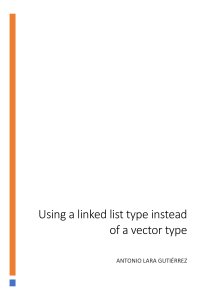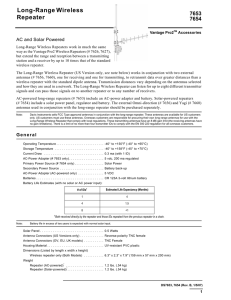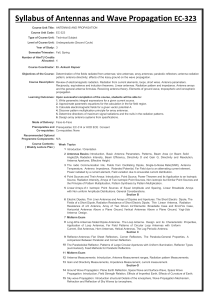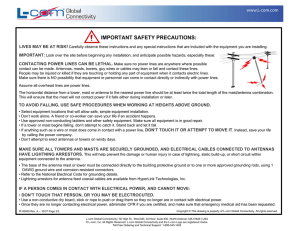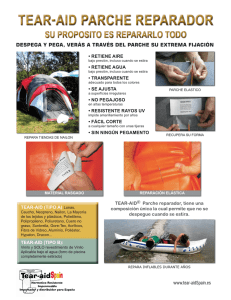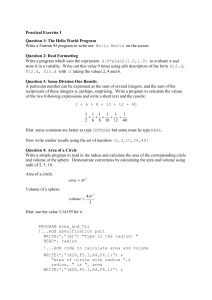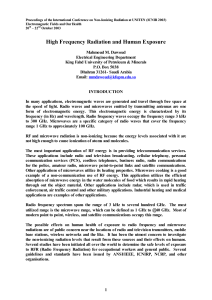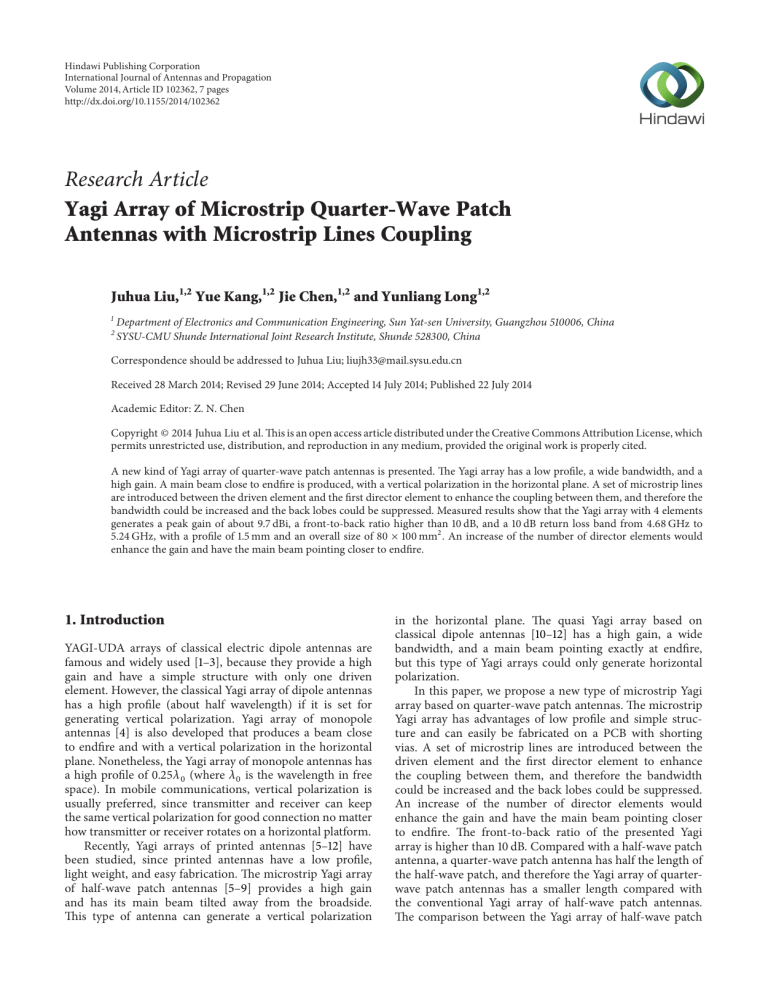
Hindawi Publishing Corporation International Journal of Antennas and Propagation Volume 2014, Article ID 102362, 7 pages http://dx.doi.org/10.1155/2014/102362 Research Article Yagi Array of Microstrip Quarter-Wave Patch Antennas with Microstrip Lines Coupling Juhua Liu,1,2 Yue Kang,1,2 Jie Chen,1,2 and Yunliang Long1,2 1 2 Department of Electronics and Communication Engineering, Sun Yat-sen University, Guangzhou 510006, China SYSU-CMU Shunde International Joint Research Institute, Shunde 528300, China Correspondence should be addressed to Juhua Liu; liujh33@mail.sysu.edu.cn Received 28 March 2014; Revised 29 June 2014; Accepted 14 July 2014; Published 22 July 2014 Academic Editor: Z. N. Chen Copyright © 2014 Juhua Liu et al. This is an open access article distributed under the Creative Commons Attribution License, which permits unrestricted use, distribution, and reproduction in any medium, provided the original work is properly cited. A new kind of Yagi array of quarter-wave patch antennas is presented. The Yagi array has a low profile, a wide bandwidth, and a high gain. A main beam close to endfire is produced, with a vertical polarization in the horizontal plane. A set of microstrip lines are introduced between the driven element and the first director element to enhance the coupling between them, and therefore the bandwidth could be increased and the back lobes could be suppressed. Measured results show that the Yagi array with 4 elements generates a peak gain of about 9.7 dBi, a front-to-back ratio higher than 10 dB, and a 10 dB return loss band from 4.68 GHz to 5.24 GHz, with a profile of 1.5 mm and an overall size of 80 × 100 mm2 . An increase of the number of director elements would enhance the gain and have the main beam pointing closer to endfire. 1. Introduction YAGI-UDA arrays of classical electric dipole antennas are famous and widely used [1–3], because they provide a high gain and have a simple structure with only one driven element. However, the classical Yagi array of dipole antennas has a high profile (about half wavelength) if it is set for generating vertical polarization. Yagi array of monopole antennas [4] is also developed that produces a beam close to endfire and with a vertical polarization in the horizontal plane. Nonetheless, the Yagi array of monopole antennas has a high profile of 0.25𝜆 0 (where 𝜆 0 is the wavelength in free space). In mobile communications, vertical polarization is usually preferred, since transmitter and receiver can keep the same vertical polarization for good connection no matter how transmitter or receiver rotates on a horizontal platform. Recently, Yagi arrays of printed antennas [5–12] have been studied, since printed antennas have a low profile, light weight, and easy fabrication. The microstrip Yagi array of half-wave patch antennas [5–9] provides a high gain and has its main beam tilted away from the broadside. This type of antenna can generate a vertical polarization in the horizontal plane. The quasi Yagi array based on classical dipole antennas [10–12] has a high gain, a wide bandwidth, and a main beam pointing exactly at endfire, but this type of Yagi arrays could only generate horizontal polarization. In this paper, we propose a new type of microstrip Yagi array based on quarter-wave patch antennas. The microstrip Yagi array has advantages of low profile and simple structure and can easily be fabricated on a PCB with shorting vias. A set of microstrip lines are introduced between the driven element and the first director element to enhance the coupling between them, and therefore the bandwidth could be increased and the back lobes could be suppressed. An increase of the number of director elements would enhance the gain and have the main beam pointing closer to endfire. The front-to-back ratio of the presented Yagi array is higher than 10 dB. Compared with a half-wave patch antenna, a quarter-wave patch antenna has half the length of the half-wave patch, and therefore the Yagi array of quarterwave patch antennas has a smaller length compared with the conventional Yagi array of half-wave patch antennas. The comparison between the Yagi array of half-wave patch 2 International Journal of Antennas and Propagation Lr Ld R D 0 Ld1 Lm Ld2 −5 −10 D2 −15 sm W p Wg sm b |S11 | (dB) D1 −20 −25 −30 d −35 −40 sg sr sd sd sd2 d −45 4.4 Lg y 4.6 4.8 5 5.2 Frequency (GHz) 4E (not coupled), HFSS 4E (coupled), HFSS x 𝜀r h z x 5.4 5.6 4E (coupled), measure 12E (coupled), measure Figure 3: Reflection coefficients for the 4-element Yagi array of quarter-wave patch antennas without microstrip lines coupling, the 4-element Yagi array with microstrip lines coupling (Figure 2), and the 12-element Yagi array with microsrip lines coupling (Figure 7). Figure 1: Top view and cross-section of the microstrip Yagi array of quarter-wave patch antennas. Figure 2: Photo for the 4-element Yagi array of quarter-wave patch antennas with the geometry shown in Figure 1. antennas and the Yagi array of quarter-wave patch antennas will be discussed in the paper. 2. Quarter-Wave Patch Antenna Yagi Array 2.1. Operation Principles. The structure of the Yagi array based four quarter-wave patch antennas is shown in Figure 1. Four quarter-wave patch antennas [13–15] and a set of coupling microstrip lines are fabricated on a substrate backed with a ground plane. The substrate could be air or dielectric substrate. The four quarter-wave patch antennas include a driven element (D), two director elements (D1 and D2), and a reflector element (R). Only the driven element is excited with a 50 Ω coaxial probe, and the other patches are parasitic radiators. Radiation is mainly generated from the open apertures of the four quarter-wave patches (the open apertures opposite to the shorting vias). Since the tangential electric field at each open aperture can be considered as a magnetic current, the Yagi array can be considered as a Yagi array of magnetic elements. With respect to the principle of duality to the classical electric dipole Yagi array, the parasitic magnetic element would act as a reflector when it has an additional capacitive component and it would act as a director when it has an additional inductive component. The reactive component of each magnetic element can be controlled by adjusting the length of the quarter-wave patch (the distance from the open edge to the shorting vias of the quarter-wave patch). Therefore, a quarter-wave patch must have a smaller length in order to have an additional inductive component (in view at the open aperture), when it acts as a director. Otherwise, a quarter-wave patch would act as a reflector when it has a larger length. The lengths of the directors and reflector need to be tuned with simulation tools (such HFSS) to have optimum values and to have the array radiating in forward direction. In order to make more power coupled into the first director from the driven element, three parallel microstrip lines with equal widths (𝑊 − 2𝑠𝑚 )/3 are introduced between them. Actually, the three coupling microstrip lines can be considered as a wide microstrip line with width 𝑊 that is cut with two slits with width 𝑠𝑚 , as shown in Figure 1. The two slits cutting the wide microstrip line are to avoid the wide microstrip line resonating as a radiating patch. Therefore, the coupling effect between the driven element and the first director element is mainly through a guided wave under the microstrip transmission lines. On the other hand, the coupling between the driven and the reflector elements and that between the first and the second elements are through space wave. International Journal of Antennas and Propagation 3 0 0 −10 −20 −30 60 150 30 −30 90 −90 (dB) (dB) 120 −10 60 −60 −20 −40 90 0 30 −30 −30 −40 0 180 −30 −20 −120 −20 120 −10 330 210 −10 150 −150 0 E𝜙 , measure E𝜙 , HFSS E𝜃 , measure E𝜃 , HFSS 300 240 0 ±180 270 E𝜙 , measure E𝜙 , HFSS E𝜃 , measure E𝜃 , HFSS (a) (b) Figure 4: Elevation (a) and azimuth (b) radiation patterns for the Yagi array (Figure 2) working at 5.1 GHz. 0 0 −10 −20 −60 −20 (dB) (dB) 90 −90 150 30 −40 180 0 −30 −120 120 −10 0 60 −30 −30 −20 120 −10 60 −30 −40 90 0 30 −30 −20 330 210 −10 150 −150 ±180 (f = 4.8 GHz) (f = 5 GHz) (f = 5.2 GHz) 0 240 300 270 (f = 4.8 GHz) (f = 5 GHz) (f = 5.2 GHz) (a) (b) Figure 5: Measured elevation (a) and azimuth (b) radiation patterns for the Yagi array (Figure 2). The width 𝑠𝑑 of the gaps between the coupling microstrip lines and the quarter-wave patches controls the coupling strength, which is usually less than the thickness ℎ of the substrate. The length 𝐿 𝑚 of the coupling microstrip lines would have an effect on the directivity and front-to-back (F/B) ratio. The length 𝐿 𝑚 is usually between 0.1 𝜆 0 and 0.15 𝜆 0 . We let all these elements have the same width 𝑊, and then we tune the length of each element to control its resonant frequency. Optimized values for the parameters of the Yagi array are given in Table 1. 2.2. 4-Element Yagi Array. Simulated and measured results for the reflection coefficient are shown in Figure 3. The array has an overall size of 100 × 80 mm2 and a profile of 1.5 mm. It shows that the simulated results agree very well with the measured ones. Measured results show that the array works in the band from 4.68 GHz to 5.24 GHz for the reflection coefficient being less than −10 dB, with a fractional bandwidth of 11.3%. The profile of the antenna is about 0.026𝜆 0 (where 𝜆 0 is the wavelength in free space). Also shown in Figure 3 is the reflection coefficient for the Yagi array without microstrip lines coupling between the 4 International Journal of Antennas and Propagation Table 1: Parameters for the Yagi arrays. 12 10 Gain (dB) 8 6 4 2 0 4.4 4.6 4.8 5 5.2 Frequency (GHz) 5.4 5.6 4E, HFSS 4E, measure 12E, measure Figure 6: Gains for the 4-element Yagi array (Figure 2) and the 12element Yagi array (Figure 7). Figure 7: Photo of the 12-element Yagi array of quarter-wave patch antennas. driven element and the first director element. It shows that the bandwidth could be greatly improved when the coupling microstrip lines are introduced. Figure 4 shows radiation patterns in the elevation plane and in the azimuth plane for the Yagi array working at 5.1 GHz. It shows that simulated results agree very well with measured ones. While not shown here, the main beam would point exactly at endfire when the array is on an infinite ground plane. Due to the finite ground plane diffraction effects, the main beam does not point exactly at endfire but at an angle of about 45–50∘ from the normal direction, when the array is in a finite ground plane. Measured results show that the cross polarization is less than −17 dB in the main elevation plane and less than −10 dB in the horizontal (azimuth) plane. The front-to-back (F/B) ratio that is used to represent the main lobe in the front quadrant over that of the reflected lobe in the back quadrant is higher than 10 dB. Figure 5 shows radiation patterns for other frequencies for the Yagi array. It shows that the beam directions are stable at an angle of about 45–50∘ from the normal direction. While not shown here, the cross polarization is also less than −10 dB for these frequencies. The back lobes for these frequencies are less than −10 dB, as shown in the horizontal plane in Figure 5. Yagi array of quarter-wave patch antennas (Figure 1) Variable Values Yagi array of half-wave patch antennas (Figure 9) Variable Values 𝜀𝑟 ℎ 𝐿𝑑 𝐿𝑟 𝐿𝑑1 𝐿𝑑2 𝑊 𝑏 𝑠𝑑 𝑠𝑚 2.33 1.57 mm 8.926 mm 9.026 mm 7.826 mm 7.626 mm 40 mm 1.4 mm 0.8 mm 0.8 mm 𝜀𝑟 ℎ 𝐿𝑑 𝐿𝑟 𝐿 𝑑1 𝐿 𝑑2 𝑊 𝑏 𝑠 𝐿𝑔 2.33 1.57 mm 17.6 mm 19 mm 15 mm 15 mm 25 mm 1.3 mm 0.8 mm 115 mm 8.4 mm 𝑊𝑔 80 mm 𝐿𝑚 𝑠𝑟 𝑠𝑑2 𝑠𝑔 3.37 mm 3.37 mm 23.67 mm 𝐿𝑔 100 mm 𝑊𝑔 80 mm 𝑑 𝑝 0.6 mm 1.5 mm Figure 6 shows the gains for the Yagi array in finite ground plane. Figure 6 shows that measured gains (dashed line) agree very well with simulated ones (dotted line). Measured results show that the array has a gain of about 9.5 dBi in the band from 4.68 GHz to 5.24 GHz. 2.3. 12-Element Yagi Array. The photo of the designed Yagi array is shown in Figure 7. The substrate, the first four patches, and the coupling microstrip lines are the same as the Yagi array shown in Figure 2. The added eight director elements are the same as the second director element that has a length of 𝐿𝑑2 = 7.626 mm, and the apertures of the added eight director elements have the same size as that of the second element. The ground plane has a length of 𝐿 𝑔 = 180 mm and a width of 𝑊𝑔 = 80 mm. The reflection coefficient for the Yagi array with 12 radiators is shown in black dashed line in Figure 2. It shows that the 12-element Yagi array works in the band from 4.64 GHz to 5.22 GHz for the reflection coefficient being less than −10 dB, with a fractional bandwidth of 11.8%. The bandwidth of the Yagi array with 12 radiators is very close to that of the Yagi array with 4 radiators. As a matter of fact, the driven and the first director elements play a much more important role in the bandwidth than other elements, since the coupling through a guided wave under the microstrip lines between the driven and the first director elements is much stronger than the coupling through space waves between other elements. Therefore, adding more director elements would not help to enhance the bandwidth in this type of Yagi array. International Journal of Antennas and Propagation 0 0 5 −10 90 −90 −30 −20 60 150 −20 −30 −40 120 −10 60 −60 (dB) (dB) −20 90 0 30 −30 30 −30 0 180 −40 −30 −120 120 −10 −20 210 330 −10 −150 0 150 240 0 ±180 270 300 (f = 4.8 GHz) (f = 5 GHz) (f = 5.2 GHz) (f = 4.8 GHz) (f = 5 GHz) (f = 5.2 GHz) (a) (b) Figure 8: Measured radiation patterns in the elevation (a) plane and in the azimuth (b) plane for the 12-element Yagi array (Figure 7). Ld L d1 12 0 9 −10 6 −20 3 L d1 W Wg b |S11 | (dB) D Gain (dBi) Lr 10 s Lg y x Figure 9: Geometry of the Yagi array of half-wave patch antennas. −30 4.8 4.9 5 5.1 5.2 5.3 Frequency (GHz) 5.4 5.5 0 5.6 5.6 Figure 10: Reflection coefficient and gain for the 4-element Yagi array of half-wave patch antennas. The gain of the antenna with 12 elements is shown in red line in Figure 6. Measured results show that the peak gain of the 12-element Yagi array is about 10.5 dBi in the band from 4.64 GHz to 5.22 GHz, which is about 1 dB higher than that of the 4-element Yagi array. Measured radiation patterns for the 12-element Yagi array are shown in Figure 8. It shows that the main beam of the 12-element Yagi array would point closer to endfire compared with the 4-element Yagi array. The beam direction is 65–75∘ entitled from the normal direction. 3. Comparisons with Yagi Array of Half-Wave Patch Antennas In this section, the Yagi array of quarter-wave patch antennas is compared with the conventional Yagi array of half-wave patch antennas. The geometry of the Yagi array of half-wave patch antennas is shown in Figure 9. To have a reasonable compassion, the two kinds of Yagi arrays are fabricated on the same substrate. The length of the driven half-wave patch antenna is twice the effective length [16] of the quarter-wave patch antenna. To prevent higher modes of the half-wave patch antenna to be excited, the width 𝑊 of the half-wave patch antennas is 25 mm, which is smaller than the width of the quarter-wave patch antennas. The parameters for the Yagi array half-wave patch antennas and those for the Yagi arrays of quarter-wave patch antennas are given in Table 1. Simulated results for the reflection coefficient and gain for the 4-element Yagi array of half-wave patch antennas are shown in Figure 10. Simulated results for the radiation patterns in the elevation and azimuth planes for the Yagi array are shown in Figure 11. Table 2 gives data for the comparisons between the Yagi array of half-wave patch antennas and the Yagi array of quarter-wave patch antennas. 6 International Journal of Antennas and Propagation 0 0 −10 60 −60 −20 −30 60 30 150 −30 −90 90 −30 −20 −40 0 180 −30 −120 120 −10 0 (dB) (dB) 120 −10 −20 −40 90 0 30 −30 −20 330 210 −10 150 −150 ±180 (f = 5.3 GHz) (f = 5.4 GHz) (f = 5 GHz) (f = 5.1 GHz) (f = 5.2 GHz) 300 240 0 270 (f = 5 GHz) (f = 5.1 GHz) (f = 5.2 GHz) (a) (f = 5.3 GHz) (f = 5.4 GHz) (b) Figure 11: Elevation radiation patterns (a) in the 𝑥𝑧 plane and azimuth radiation patterns (b) in the 𝑥𝑦 plane for the 4-element Yagi array of half-wave patch antennas. Table 2: Comparisons between the Yagi array of quarter-wave patch Antennas and the Yagi array of half-wave patch antennas. Character Band Fractional bandwidth Beamwidth (elevation plane) Beamwidth (azimuth plane) Gain Front-to-back ratio Radiation angle (from broadside) Radiation efficiency Size of driven patch Size of ground plane Yagi array of quarter-wave patch antennas (Figure 1) Yagi array of half-wave patch antennas (Figure 9) 4.68–5.24 GHz 5.0–5.43 GHz 11.3% 8.25% 56–58∘ 42–46∘ 44–60∘ 80–87∘ 8.65–9.9 dBi >10 dB 8.28–10.19 dBi >7.4 dB 45–50∘ 35–40∘ 91–98% 8.926 × 40 mm 100 × 80 mm2 95–99% 2 17.6 × 25 mm2 115 × 80 mm2 From Table 2, it is seen that the bandwidth of the Yagi array of quarter-wave patch antennas is slightly wider than the Yagi array of half-wave patch antenna. The size of the ground plane for the Yagi array of quarter-wave patch antenna is smaller than that for the Yagi array of halfwave patch antenna, because the length of each quarter-wave patch antenna is only half the length of the corresponding half-wave patch antenna. The main beam of the Yagi array of quarter-wave patch antennas points closer to endfire than that of the Yagi array of half-wave patch antennas, because a single quarter-wave patch antenna has an almost omnidirectional pattern in upper half-space (when in infinite ground plane) while a single half-wave patch antenna has its main beam point at broadside [6]. The F/B ratio for the Yagi array of quarter-wave patch antennas is higher than that for the Yagi array of half-wave patch antennas. The gains are almost the same for the two kinds of Yagi arrays. The efficiency for the Yagi array of quarter-wave patch antennas is not as high as that for the Yagi array of quarter-wave antennas due to the conducting loss of the shorting vias in the quarterwave patch antennas. Actually, the shorting-vias may also result in a sloppy fabrication, so the period of the shortingvias should not be too small (the period of the shorting-vias is about 2–2.5 times the diameter of the shorting-vias [16]). 4. Conclusion A new type of Yagi array of quarter-wave patch antennas has been presented and studied. The Yagi array has a wide bandwidth and a high gain and provides a vertical polarization in the horizontal plane. A Yagi array with 4 microstrip quarterwave patch antennas is designed and measured. Measured results show that the Yagi array generates a gain of about 9.5 dBi and a bandwidth of 11.3%, with an overall size of 100 × 80 mm2 and a profile of 1.5 mm. An increase of director radiators of the Yagi array would enhance the gain and has the main beam pointing closer to endfire. Compared with the classical Yagi array of half-wave patch antennas, the presented Yagi array of quarter-wave antennas has a smaller length, a slightly wider bandwidth, a beam closer to endfire, and a higher F/B ratio. However, the efficiency of the Yagi array of quarter-wave patch antennas is not as high as that of the Yagi array of half-wave patch International Journal of Antennas and Propagation antennas. Both types of Yagi arrays have almost the same gains. Conflict of Interests The authors declare that there is no conflict of interests regarding the publication of this paper. Acknowledgment This work was supported in part by the Research Project of Guangdong Province (2012B090600009). References [1] H. Yagi, “Beam transmission of the ultra short waves,” Proceedings of the IEEE, vol. 16, pp. 715–741, 1928. [2] J. D. Kraus and R. J. Marhefka, Antennas: For All Applications, chapter 8, McGraw-Hill, New York, NY, USA, 2002. [3] T. A. Milligan, “Traveling-wave antennas,” in Modern Antenna Design, chaper 10, John Wiley & Sons, Hoboken, NJ, USA, 2nd edition, 2005. [4] A. Blalanis, Modern Antenna Handbook, John Wiley & Sons, New York, NY, USA, 2008. [5] J. Huang, “Planar microstrip Yagi array antenna,” in Proceedings of the Digest Antennas and Propagation Society International Symposium, vol. 2, pp. 894–897, San Jose, Calif, USA, June 1989. [6] J. Huang and A. C. Densmore, “Microstrip Yagi array antenna for mobile satellite vehicle application,” IEEE Transactions on Antennas and Propagation, vol. 39, no. 7, pp. 1024–1030, 1991. [7] G. R. DeJean and M. M. Tentzeris, “A new high-gain microstrip Yagi array antenna with a high front-to-back (F/B) ratio for WLAN and millimeter-wave applications,” IEEE Transactions on Antennas and Propagation, vol. 55, no. 2, pp. 298–304, 2007. [8] G. R. DeJean, T. T. Thai, S. Nikolaou, and M. M. Tentzeris, “Design and analysis of microstrip bi-yagi and quad-yagi antenna arrays for WLAN applications,” IEEE Antennas and Wireless Propagation Letters, vol. 6, pp. 244–248, 2007. [9] T. T. Thai, G. R. DeJean, and M. M. Tentzeris, “Design and development of a novel compact soft-surface structure for the front-to-back ratio improvement and size reduction of a microstrip Yagi array antenna,” IEEE Antennas and Wireless Propagation Letters, vol. 7, pp. 369–373, 2008. [10] W. R. Deal, N. Kaneda, J. Sor, Y. Qian, and T. Itoh, “A new quasi-yagi antenna for planar active antenna arrays,” IEEE Transactions on Microwave Theory and Techniques, vol. 48, no. 6, pp. 910–918, 2000. [11] N. Kaneda, W. R. Deal, Y. Qian, R. Waterhouse, and T. Itoh, “A broad-band planar quasi-Yagi antenna,” IEEE Transactions on Antennas and Propagation, vol. 50, no. 8, pp. 1158–1160, 2002. [12] P. R. Grajek, B. Schoenlinner, and G. M. Rebeiz, “A 24GHz high-gain Yagi-Uda antenna array,” IEEE Transactions on Antennas and Propagation, vol. 52, no. 5, pp. 1257–1261, 2004. [13] R. A. Sainati, CAD of Microstrip Antennas for Wireless Application, Artech House, Norwood, Mass, USA, 1996. [14] S. Pinhas and S. Shtrikman, “Comparison between computed and measured bandwidth of quarter-wave microstrip radiators,” IEEE Transactions on Antennas and Propagation, vol. 36, no. 11, pp. 1615–1616, 1988. 7 [15] Y. X. Guo, K. M. Luk, and K. F. Lee, “L-probe proximity-fed short-circuited patch antennas,” Electronics Letters, vol. 35, no. 24, pp. 2069–2070, 1999. [16] Y. Cassivi, L. Perregrini, P. Arcioni, M. Bressan, K. Wu, and G. Conciauro, “Dispersion characteristics of substrate integrated rectangular waveguide,” IEEE Microwave and Wireless Components Letters, vol. 12, no. 9, pp. 333–335, 2002. International Journal of Rotating Machinery Engineering Journal of Hindawi Publishing Corporation http://www.hindawi.com Volume 2014 The Scientific World Journal Hindawi Publishing Corporation http://www.hindawi.com Volume 2014 International Journal of Distributed Sensor Networks Journal of Sensors Hindawi Publishing Corporation http://www.hindawi.com Volume 2014 Hindawi Publishing Corporation http://www.hindawi.com Volume 2014 Hindawi Publishing Corporation http://www.hindawi.com Volume 2014 Journal of Control Science and Engineering Advances in Civil Engineering Hindawi Publishing Corporation http://www.hindawi.com Hindawi Publishing Corporation http://www.hindawi.com Volume 2014 Volume 2014 Submit your manuscripts at http://www.hindawi.com Journal of Journal of Electrical and Computer Engineering Robotics Hindawi Publishing Corporation http://www.hindawi.com Hindawi Publishing Corporation http://www.hindawi.com Volume 2014 Volume 2014 VLSI Design Advances in OptoElectronics International Journal of Navigation and Observation Hindawi Publishing Corporation http://www.hindawi.com Volume 2014 Hindawi Publishing Corporation http://www.hindawi.com Hindawi Publishing Corporation http://www.hindawi.com Chemical Engineering Hindawi Publishing Corporation http://www.hindawi.com Volume 2014 Volume 2014 Active and Passive Electronic Components Antennas and Propagation Hindawi Publishing Corporation http://www.hindawi.com Aerospace Engineering Hindawi Publishing Corporation http://www.hindawi.com Volume 2014 Hindawi Publishing Corporation http://www.hindawi.com Volume 2014 Volume 2014 International Journal of International Journal of International Journal of Modelling & Simulation in Engineering Volume 2014 Hindawi Publishing Corporation http://www.hindawi.com Volume 2014 Shock and Vibration Hindawi Publishing Corporation http://www.hindawi.com Volume 2014 Advances in Acoustics and Vibration Hindawi Publishing Corporation http://www.hindawi.com Volume 2014
